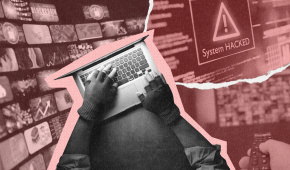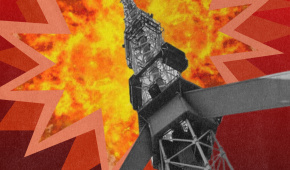IMI turns 28. Who we are and what we do
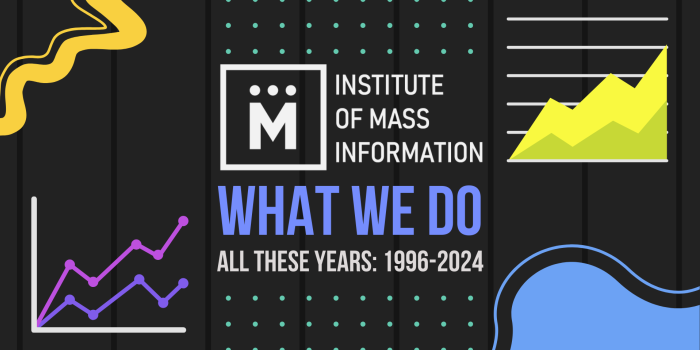
The Institute of Mass Information turns 28.
It all started even earlier than that: Ukrainian and foreign journalists founded the IMI on October 10, 1995. And on February 20, 1996, the CSO "Institute of Mass Information" was officially registered by the Ministry of Justice.
What does the Institute of Mass Information do?
During this time, the IMI has expanded and evolved:
- Helped develop at least ten draft bills and media reforms, as well as orders and other documents regulating the work of the media and Ukraine's information space.
- Released over 15 manuals for journalists, gave hundreds of training classes to thousands of Ukrainian media workers.
- Contributed to the investigation of hundreds of crimes against journalists, actively worked with the law enforcement as part of task forces.
- Opened 11 Mediabazas in Chernihiv, Sumy, Kharkiv, Dnipro, Poltava, Zaporizhzhia, Mykolaiv, Kherson, Kropyvnytskyi, Odesa and Zhytomyr, which were used by media workers almost 7 thousand times.
- The IMI is a co-founding organization of the Media Movement, which now unites over 100 media outlets and journalists from across Ukraine.
- Contributed to the increase in Ukrainian online media's adherence to professional standards by over 15% on average. The invasion showed that Western journalists have a lot to learn from their Ukrainian colleagues.
- Started documenting Russia's crimes against the media and journalists, developed methodologies and terminology for documenting the crimes of Russian propagandists, and began active work in this line.
- Provided over 150 mini-grants to media outlets, developed a robust body of organizational procedures and policies.
- Had active involvement in the development of self- and co-regulation in the Ukrainian media market; started the "Mediacheck" initiative in partnership with "Detector Media", co-founded the Independent Media Council; IMI experts are also members of the Independent Media Council and the Commission on Journalistic Ethics.
- Became the only Ukrainian organization to join the International Organization for the Protection of Freedom of Speech (IFEX) and partnered with the international organizations "Reporters without Borders" and Freedom House.
- Received numerous international awards, including the Human Rights Tulip, the Journalism Achievement Award from the Internews Network, the Kurt Schork Memorial Fund Award and other prizes, some as part of the human rights coalition "Ukraine 5AM".
The Institute of Mass Information defends freedom of speech and journalists, studies various occurrences in the media field, monitors the Ukrainian media's adherence to standards, writes draft bills, gives safety equipment and financial aid to media workers, provides media teams with equipment necessary for their survival, and more.
The IMI has 20 regional representatives on the ground, helping us understand and quickly adapt to the media teams' problems and needs and offer our support to journalists promptly.
This article outlines what we have been doing over the years and how Ukrainian media has changed during this time.
The Freedom of Speech Barometer
The IMI has been recording crimes against the media and journalists in Ukraine since 2012. In these years, two peaks in violations occurred: the Revolution of Dignity together with the start of the Russo–Ukrainian war and Russia's full-scale invasion.
The Freedom of Speech Barometer has become the basis for numerous freedom of speech campaigns, statements or actions. It was also the basis for the development of bills and responses from international organizations assessing the state of affairs in Ukraine. It yielded response from the Ukrainian authorities and law enforcers investigating violations of journalists' rights in Ukraine.
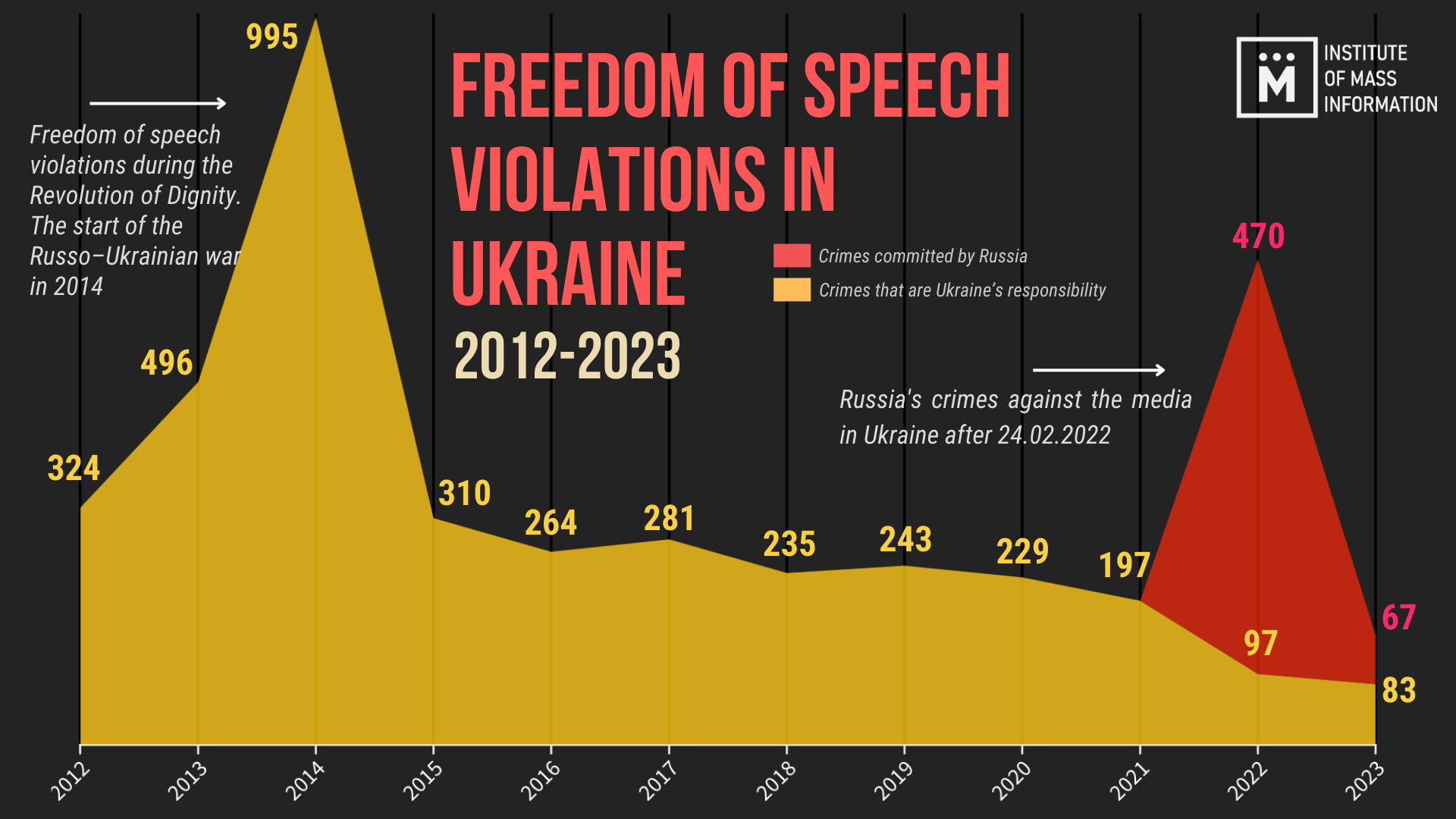
Freedom of speech violations in Ukraine 2013–2023
"In 2013–2014, the journalists' rights were most often violated by law enforcers and local officials. The journalists covering protests, illegal construction, and mass events were affected the most. Media offices were targeted: from windows being shot at to cables being cut. Ukrainian journalists also faced a new challenge – numerous DDoS attacks and cybercrimes," said Kateryna Diachuk, head of the freedom of speech monitoring department at the Institute of Mass Information. In those days, at least five journalist teams left their newsrooms and "vanished" due to censorship, unwilling to work amid pressure on editorial policies.
In 2014, IMI kept a list of media workers injured during the Maidan, which includes over 200 people. Later, the list became an important piece of evidence of the crimes of the Yanukovych regime and of Russia's crimes against Ukrainian journalists. For instance, the IMI recorded the Russians kidnapping more than 80 media workers and purposefully destroying independent media resources in 2014–2015. Over a thousand media outlets in Crimea were eradicated under occupation. The IMI was reporting these data on all international platforms and passing them on to international organizations and Ukrainian law enforcement bodies.
The next peak in journalists' rights violations coincided with Russia's full-scale invasion. On the very first day, February 24, 2022, the IMI started documenting Russian crimes against the media and journalists as a separate monitoring. Over the years, we have recorded hundreds of crimes committed by Russia: dozens of murders, abductions, shootings and woundings of journalists.
There were also targeted strikes on TV towers, death threats, attacks on media offices, cybercrimes, disabling Ukrainian broadcasting, brand misappropriation and clones of local media outlets and TV channels created to spread aggressive Russian propaganda. Moreover, due to the full-scale war, at least 234 media outlets had to close down. These were located not just in the oblasts where combat or occupation had taken place, but in the relatively peaceful areas as well – a result of the financial crisis triggered by the war.
Not only we record crimes against the media, but also report them to law enforcers for investigation and prosecuting the perpterators. The full-scale invasion affected these indicators as well. For instance, because most crimes are committed by Russians, bringing the culprits to justice in Ukrainian courts is nearly impossible.
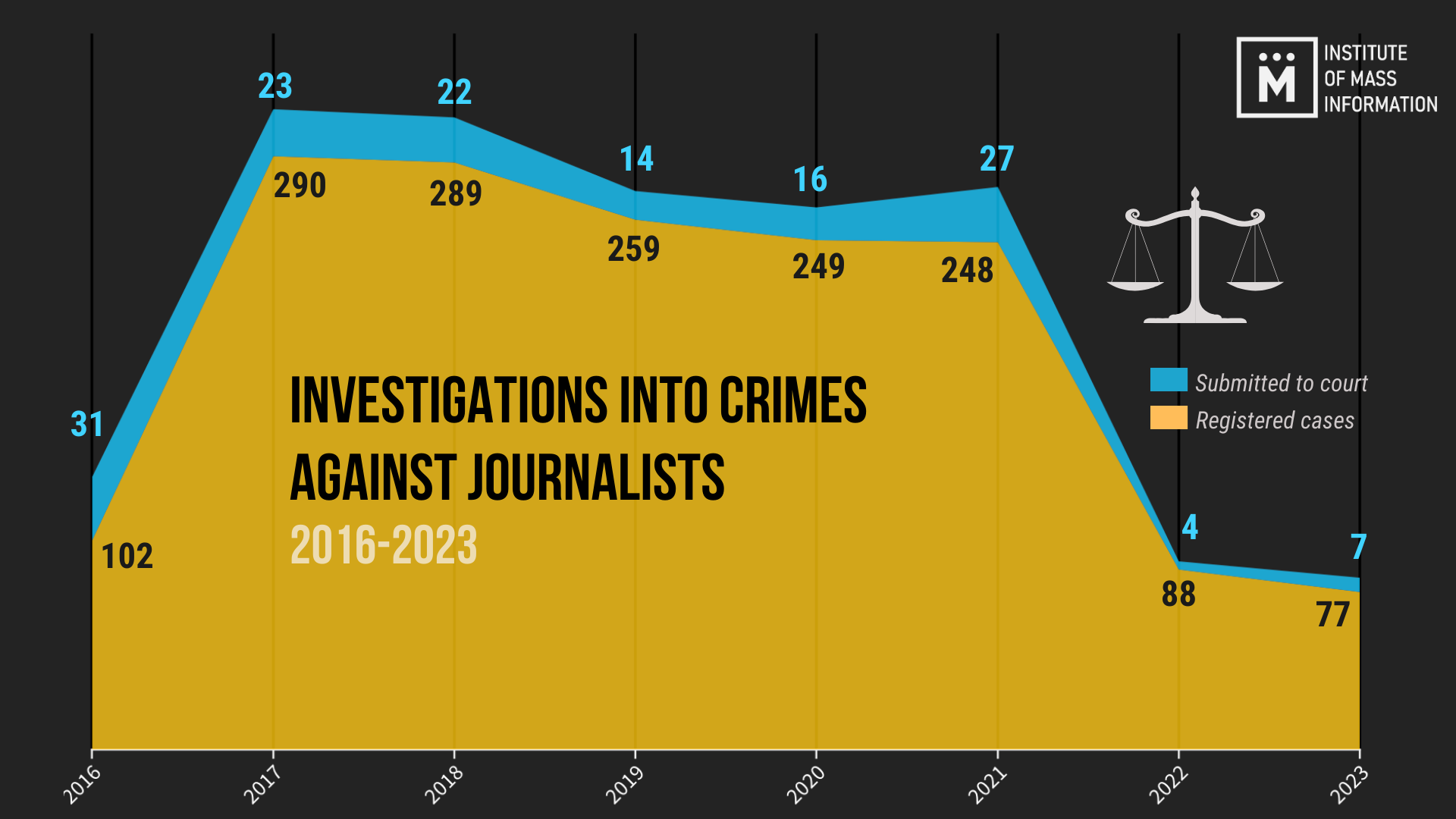
Investigations into crimes against journalists 2016–2023
Law advice for media workers
Law advice grew more popular year after year until we reached 342 consultations in 2020. Please note that this is essentially a consultation every day, including weekends. The calls to the IMI hotline peaked during the elections, followed by quarantine restrictions at the onset of the COVID-19 pandemic, when journalists were being arbitrarily barred from attending courts or local council meetings. This was not happening because of the quarantine, but because the officials didn't want to see the journalists there.
In 2022, the demand dropped due to the full-scale invasion, as journalists became more interested in safety than legal issues. However, we saw an uptick in calls to our hotline in 2023 and we expect the number to keep growing in 2024.
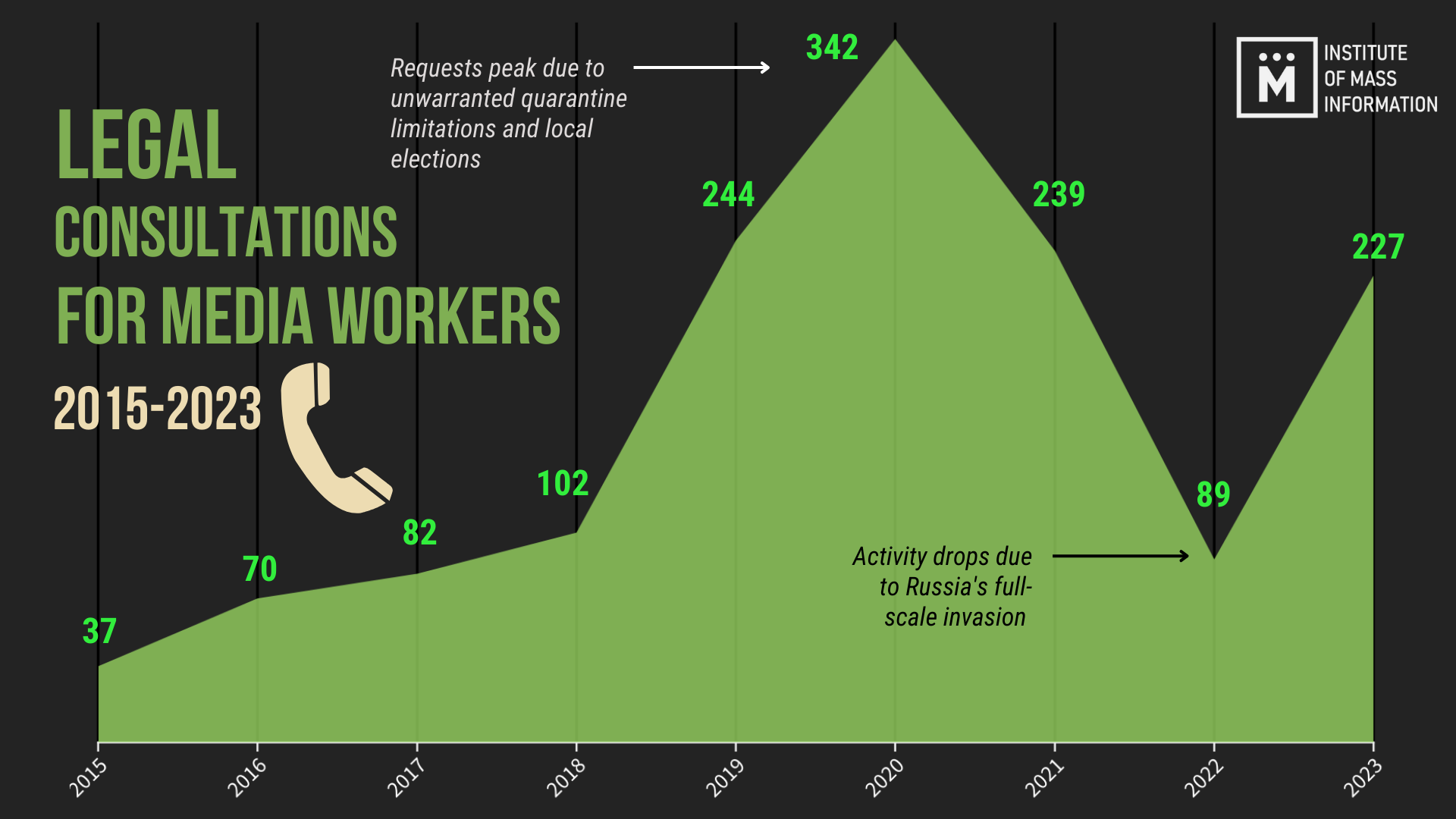
Legal consultations for media workers 2015–2023
The Institute of Mass Information operates a law consulting hotline where journalists can get advice from experts in media law or assistance in drafting documents/editorial policies and pre-release proofreading. To request help, see the contact information below:
- (050) 447-70-63
- [email protected]
Providing journalists with safety gear
We began handing out safety gear in 2013, during the Revolution of Dignity. First it was construction helmets, orange "PRESS" vests and orange stickers. We learned and evolved until we also started offering ski helmets, ballistic goggles, respirators, and first-aid kits.
"During the Revolution of Dignity, journalists started contacting us en masse, asking, 'What should we do?' We printed thousands of PRESS stickers overnight, ordered a thousand orange vests, went to construction supplies stores and bought construction helmets and respirators. We believed journalists should be wearing every possible marker, according to international rules. But within a few days, Berkut officers started aiming directly at our stickers while throwing stones and shooting rubber bullets. We quickly revised our strategy: that's how we got white vinyl stickers saying PRESS in English, a hundred ski helmets and level II bulletproof vests," said Iryna Zemlyana, an experienced safety expert and coach at the Institute of Mass Information.
As soon as March 2014, during the occupation of Crimea, we realized that we had to look for serious body armor. In those days, it was simply impossible to buy safety gear and helmets, because everyone needed them, primarily volunteers and soldiers. It took a miracle for a private company to sell us body armor – and the miracle did happen. The Azov Battalion wrote a letter of recommendation for us, saying that they respected the work of journalists and considered it important. This is the only way were we able to obtain the legendary first 40 level IV bulletproof vests for media workers. We tested them responsibly at firing ranges, made sure that the armor was sturdy, and started handing them out. We even managed to procure Kevlar helmets somehow.
"In 2014 and 2015, the office was busy as a beehive: someone constantly arriving to take something or give something back. Journalists were spending time at our office, sharing their impressions of the war, brought us shell fragments and various 'gifts' as thanks. At the same time, we were providing aid to relocated journalists and to those who were back from captivity. We wrote down their stories and sought out advice for them. That's how the idea of giving media workers training grounds classes emerged – we were the first in Ukraine to offer them," Iryna Zemlyana recalls.
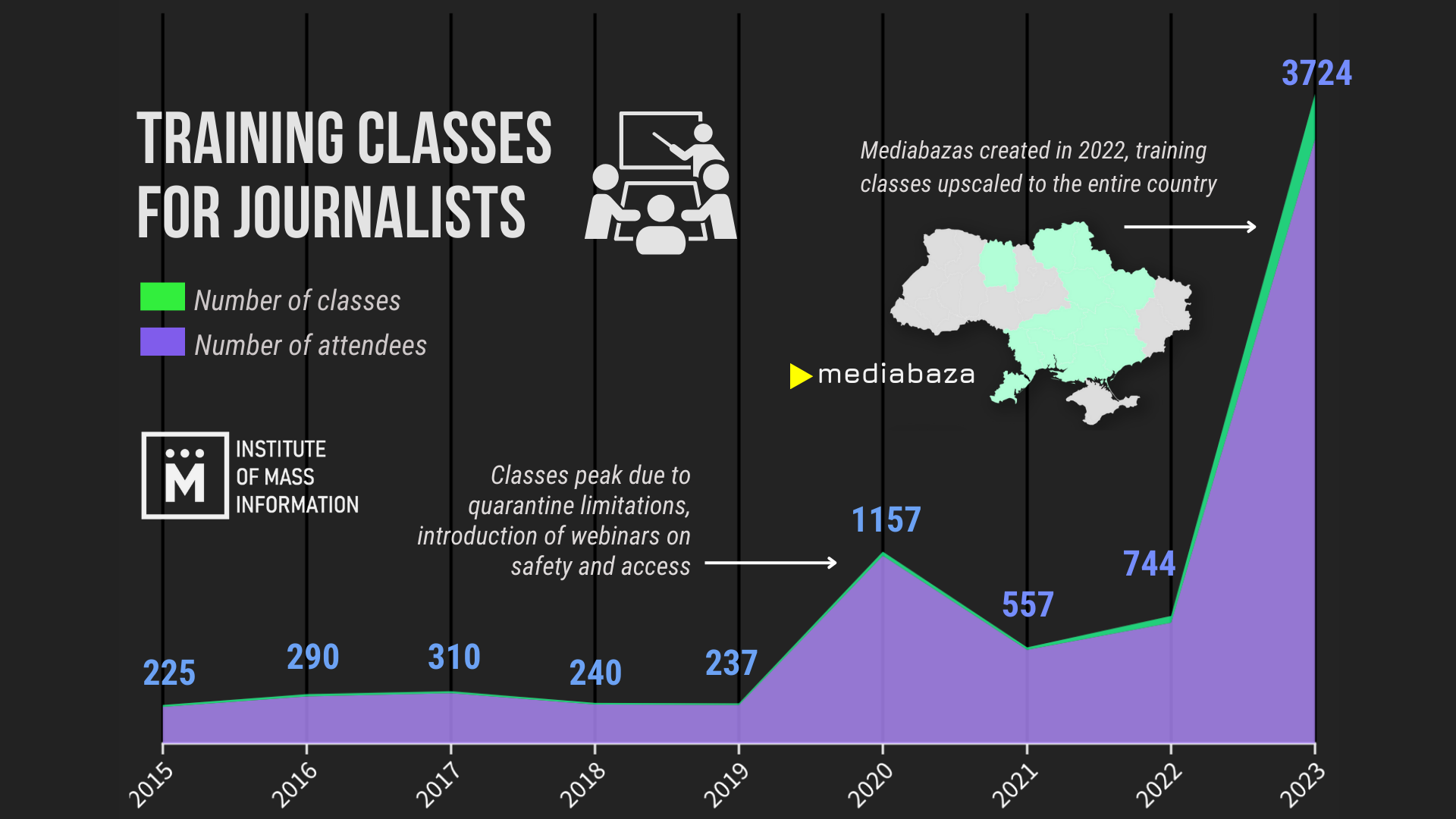
Training classes for journalists 2015–2023
The first class took place in December 2014. Four days of training in first aid, handling equipment, safety techniques and wartime hazards. Later, we gave over 20 such classes for several hundred journalists who are successfully working on the front lines today.
We continued fundraising for armor. For example, random foreign citizens to whom Iryna Zemlyana spoke about journalists working in wartime, donated several hundred dollars, which the IMI used to buy the first batch of blue PRESS bulletproof vests with full neck, arms, and groin protection. We resumed our training in 2021 and carried out five trips to training grounds and bought five sets of body armor right before the full-scale invasion.
In 2022, our workload with safety equipment for media workers increased tenfold. Thanks to our partners and donors, we started importing hundreds of level IV bulletproof vests, Kevlar helmets and tactical first-aid kits, immediately issuing them to journalists who were going to work in the combat area. In the first two months after the start of the invasion, the IMI has completely restructured to become a network of like-minded people throughout Ukraine and abroad saving Ukrainian journalism. We started delivering equipment for journalists and the media all across Ukraine, under shelling and even to the occupied territories. Over the past two years, our equipment has been used over 9,000 times. It was and still is important for us that journalists can work and document Russia's crimes, because the world must know about them.
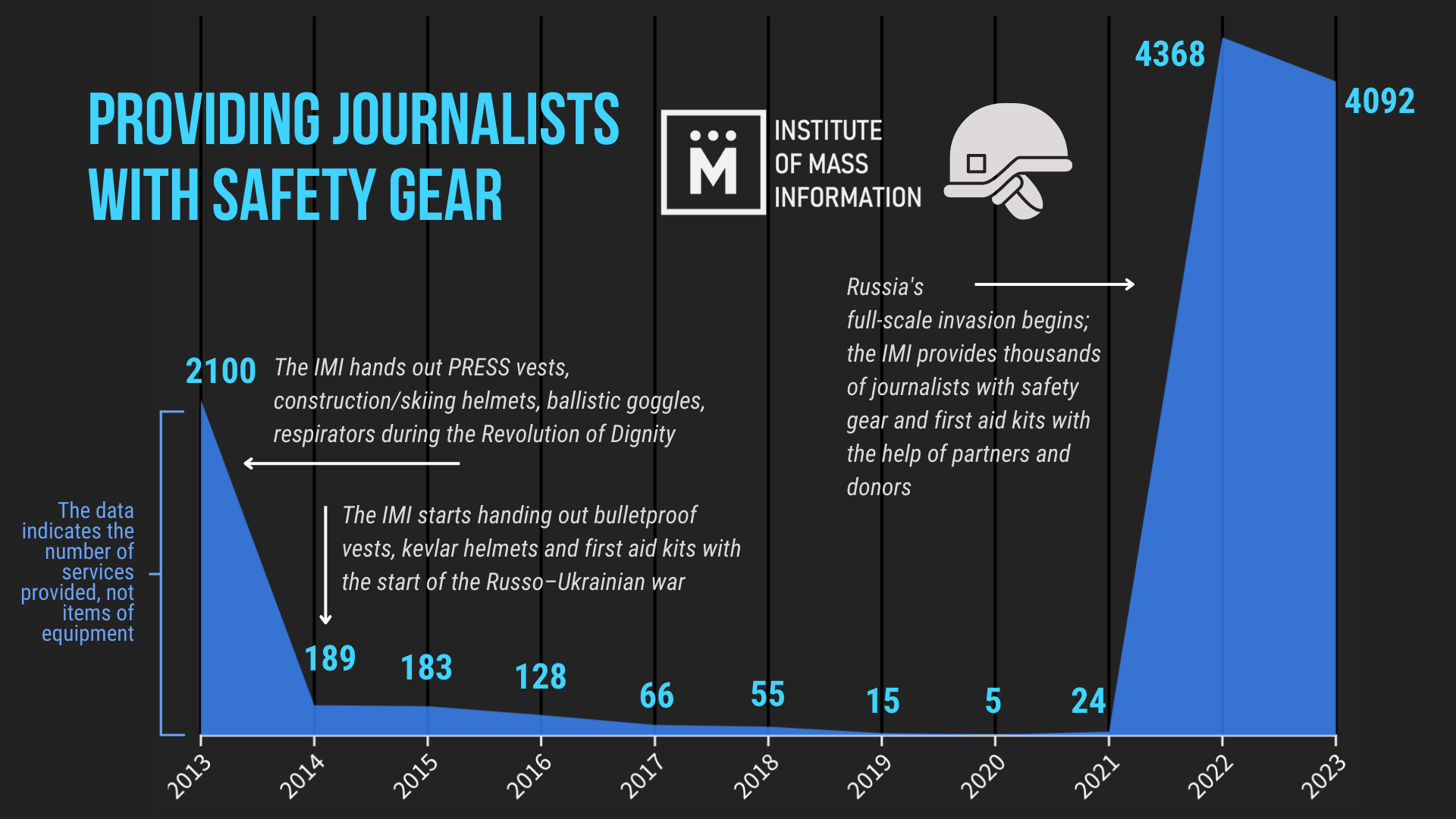
Providing journalists with safety gear 2013–2023
"Throughout the first year of the full-scale invasion, we were issuing about 10–20 sets of body armor almost every day. Both to Ukrainian and foreign journalists. We, once media experts and analysts, became safety and first aid coaches to explain to media workers how to use the protective equipment, to give them individual mini-classes; we learned about other equipment needed for wartime work and tried to get it," said Olena Holub, a media expert at the Institute of Mass Information. In the first days of the full-scale invasion, Olena joined the territorial defense forces as a paramedic, was given international training, and her knowledge has helped protect journalists in the years of the war.
After the strikes on the infrastructure, we started handing out generators, power stations, power banks and various useful supplies to editorial offices. We also offered help to journalists who lost their equipment, means to work, or otherwise faced hardship due to the full-scale invasion.
Mediabazas
On November 15, 2022, the Institute of Mass Information launched the network of regional hubs for journalists "Mediabaza". Our goal was to create "points of invincibility" for employees of local newsrooms. We provided a workplace for journalists during blackouts, supplied them with bulletproof vests, helmets, and other equipment, gave training classes and helped media workers communicate with the authorities and the military.
Over 6,700 Ukrainian and foreign media workers have used the services of the Mediabazas since November 2022: they went there to work, learn, rent equipment, speak with state officials, write joint statements or just chat with like-minded people and cuddle a dog (Note: the dog cuddling service is not yet available in all oblasts, but we are working on it!).
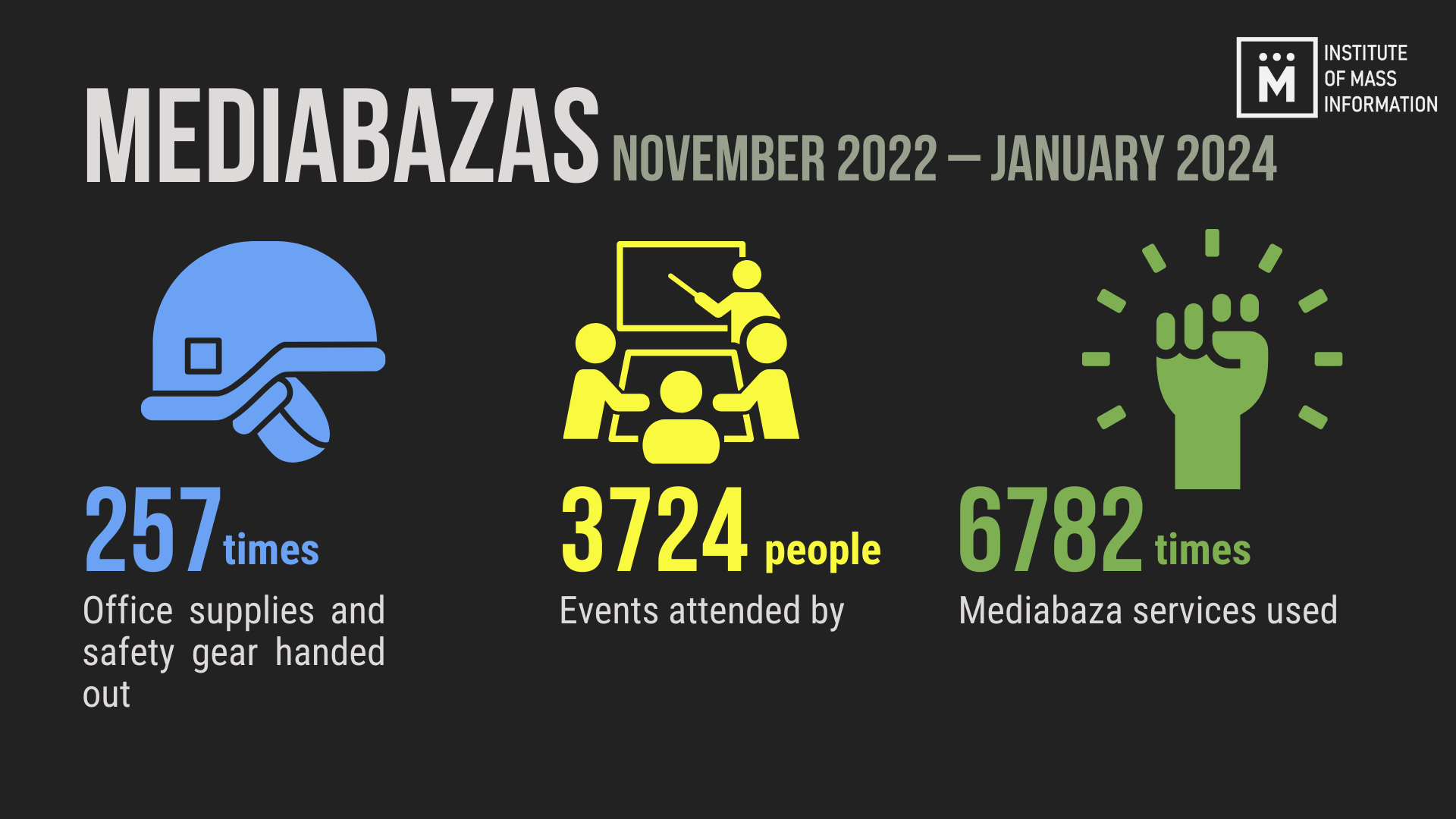
The results of the work of the Mediabazas by the Institute of Mass Information
Today, Mediabazas operate in 11 cities:
Monitoring online media
In October 2010, the Institute of Mass Information released its first journalistic standards monitoring analyzing five print media outlets. In 2013, we added four online media outlets, applying a special system of points to monitor them. In 2017, we largely overhauled our methodology, expanding it to monitor more and more outlets. We were closely in touch with almost every outlet; they have told us that the monitoring helped them motivate their employees, communicate with donors and advertisers more confidently, and grow professionally.
In 2019, the IMI removed print media from our monitoring, significantly expanding the number of online outlets instead. Currently, the IMI consistently monitors over 25 online media outlets, as we were quick to notice their development prospects and focus on them.
"One of the IMI's tasks is to ensure increasing respect and trust in Ukrainian high-quality media. It is for this purpose that we started our professional standards monitoring. We try to always keep in touch with the media that are subject to our monitoring in order to improve their quality. Media outlets often contact the IMI, asking to be included in the monitoring, which shows that our analysis has the recognition of the media community," says IMI expert Olena Holub.
In 2017, Olena Holub wrote and released the manual "Mediacompass: a professional journalist's guide", drawing on the IMI monitoring.
Furthermore, the IMI often issues recommendations for the media to improve their professional and ethical standards. In 2008, the IMI was the first in Ukraine to begin monitoring jeansa on an ongoing basis. Now we permanently monitor content with signs of being commissioned and find the most prominent figures of both political and commercial jeansa. The analysis is based on IMI's own methodology, which became the basis for the Wikipedia entry describing this phenomenon.
The White List
In 2019, the Institute of Mass Information started a new large-scale project to support high-quality media, which has already attracted a million followers. The White List is known and cited by the media and journalists, experts, officials, deputies, law enforcers, international organizations (although, just in case: the official name of this ranking is "Top Transparent and Accountable Online Media List).
This project was inspired by global initiatives to enhance trust in high-quality media. The IMI's analysis methodology is unique, adapted to suit the Ukrainian context, and includes 12 criteria which are used to assess the top 50 media outlets whose average monthly audience exceeds 1–1.3 million. Due to the uptick in requests for such an assessment, IMI plans to abadnon this limitation and give different media outlets a chance to show themselves.
As of now, the analysis is biannual (released twice every year).
"At the start of the project we were faced with some skepticism, as it often happens with new ideas. However, having posted our first list, we almost immediately noticed considerable interest from the media. Since the project has a purely positive motivation, more and more media want to be included in the analysis," noted IMI expert Olena Holub.
Monitoring Russian disinformation and genocidal rhetoric
The IMI has been monitoring Russian disinformation for 10 years: we have witnessed and documented the Kremlin regime deploying its aggressive propaganda machine against Ukraine. The propagandists were the vanguard of the Russian invasion, working to distort the facts and construct a myth about Russia the "innocent goody-two-shoes seeking peace." When the Russian troops were already on the ground in Crimea, we were faced with the Western media not understanding our arguments, because they were taught that they should report on everyone's perspective of events. By now, in 2024, it is already clear that giving voice to the Russian perspective is the same as promoting the "flat Earth" theory. We made a lot of efforts to counteract this, and we are glad that the Western media began to approach Russia's information more critically.
Before the full-scale invasion, in 2021, we recorded a sharp spike in aggressive Russian propaganda – by almost two and a half times. The Russians' aggressiveness and lies peaked in February–March 2022, back when they hoped to "take Kyiv in three days."
In 2022, we proposed a new term to describe the phenomenon of Russian propaganda correctly – genocidal rhetoric. To outline the signs of such rhetoric, the Institute of Mass Information draws on the definitions in the indictment against Félicien Kabuga, a Rwandan oligarch and founder of the Radio Télévision Libre des Mille Collines whom ICC prosecutors accused of using genocidal rhetoric. We see all these signs in Russian aggressive propaganda and hope to see Russian propagandists on the bench of an international tribunal one day.
Another reason why this work is important is because international organizations initially "saw no signs" of genocide that was being committed by Russia against Ukraine. It was the media aspect of it that forced these organizations to reconsider their stance and really "notice" public incitement to genocide – and therefore the crime itself – at last.
Women's visibility in online media
In 2013, we launched the first gender balance monitoring of the Ukrainian media. We faced a huge backlash, people calling us crazy, texting us with insults and death threats. Years down the line, our methodology has become the basis for other similar monitorings in Ukraine. By now such studies are perceived as perfectly normal. This methodology earned us several awards from the human rights organization "La Strada".
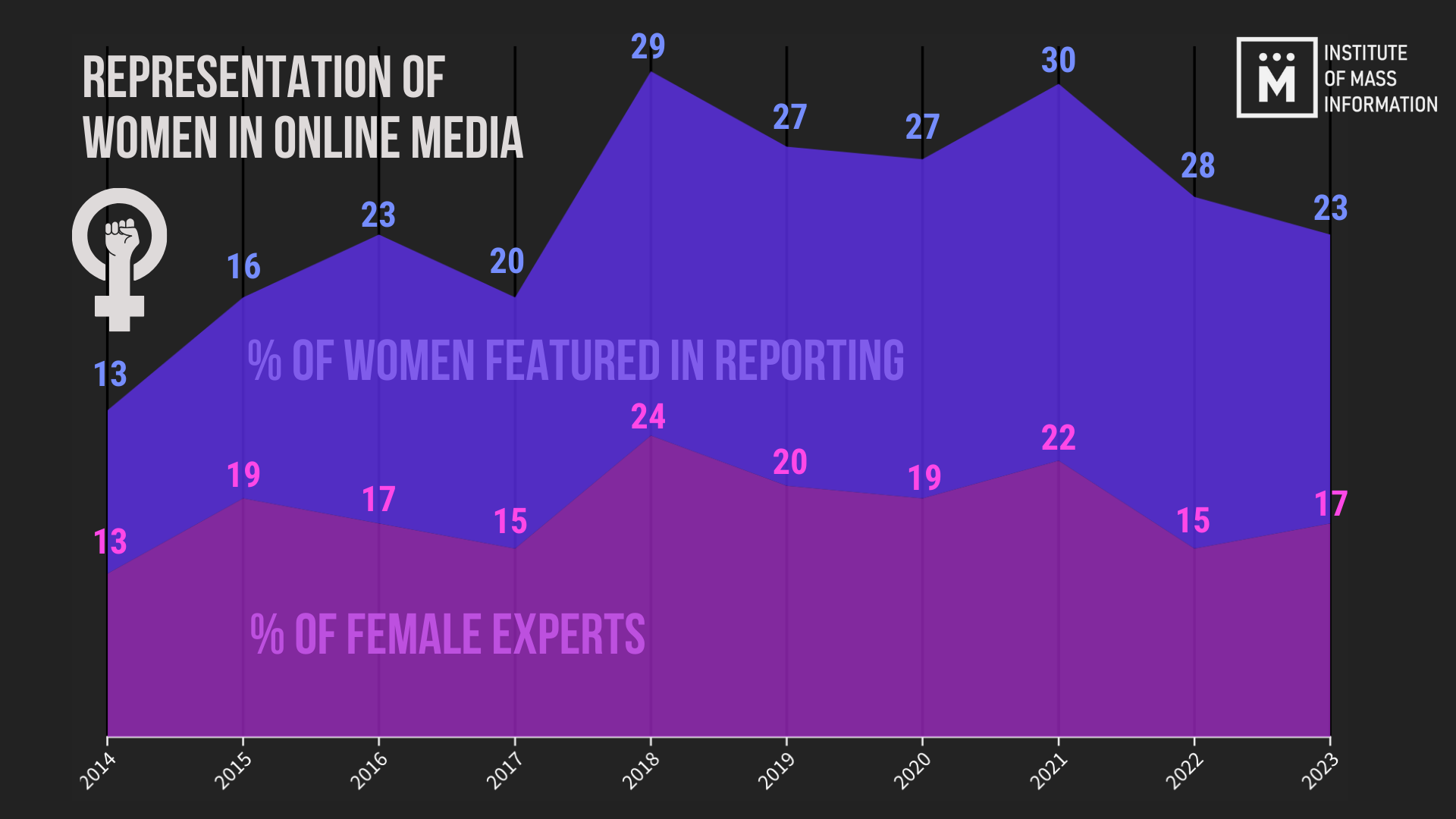
Representation of women in online media 2014–2023
In 2016, we launched the gender-balanced database of experts Expert4.media, which helped journalists from all over Ukraine contact the best experts. This even introduced media teams to some new topics for reporting. We implemented another project in 2020, gathering prominent experts from all over Ukraine at the Women's Publicity Academy – a series of webinars that inspired over 200 women to be confident while working with the media.
Our research shows that a significant drop in the number of women featured in reporting was another negative consequence of the Russian invasion. Until 2022, this indicator had been growing year after year. But in 2022, all news feeds changed, news about combat operations and the impact of war coming to the fore. The presence of female experts fell back to the 2014 level.
"One of the tasks we set before ourselves is to increase the visibility of women in the media, to motivate editors to involve women in their materials as experts. We cannot expect the gender balance indicators to grow in the near future, since nobody knows how long the war will last and what topics will be relevant. In my opinion, however, the management of editorial teams and the public's interest in this issue play an important role in influencing the situation. Editorial offices should develop according policies, outlining their standards, rules, ethics. We at the IMI are always ready to provide advice and help develop these policies," comments Yana Mashkova, a researcher at the Institute of Mass Information.
*****
P.S.
It took us a week to write this, as writing about yourself is more difficult than about anything else. And still we could not describe all of our legs, arms, heads and tails. We hope this helped you understand a little better that the Institute of Mass Information is multifaceted and diverse. Our values are justice, moving forward, giving assistance, maintaining quality and teamwork.
Thank you for your interest and trust!
(And if you feel inspired to donate to us, click here).
Help us be even more cool!

